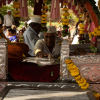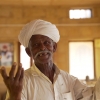Of all the percussion instruments that form part of temple music traditions, and as an integral part of the performing arts traditions of Kerala, the mizhavu is impressive in many respects. It is the single major musical instrument for Kutiyattam, the sole extant form of ancient Sanskrit theatre in India. It is also the main musical instrument for Nangiarkuttu, the female counterpart of Kutiyattam. Mizhavu is the instrument that punctuates the Kuttu, the story-telling tradition of the Chakyars, which dates back centuries.
Evolution
There is till date no historical evidence to prove the antiquity of mizhavu. For a long time, the instrument has been handled by Nambiars, the Hindu temple caste. The Nambiar community relates the origin of mizhavu to the cosmic dance of Lord Siva. They believe that Lord Nataraja danced to the music of mizhavu played by Nandikeswara. It is in fact a prevailing belief among percussionists in Kerala that Nandikeswara played their musical instruments─mizhavu/timila/maddhalam/edayyka─and the same was entrusted to the Marars/Poduwals at some point in time. It would be interesting to find out when and how mizhavu became the background instrument of Kutiyattam. The mizhavu was traditionally confined to the kuttampalams (structures attached to the temple for the staging of Kutiyattam) and at a certain point in the history of temples, it found a space in the nalambalam to accompany the Chakyars who did the Kuttu. If the first stage performances of Kutiyattam were the presentations of Subhadradhananjayam and Tapatisamvaranam by King Kulasekhara Varman (10th-11th centuries), the mizhavu probably came into being around the same period.
The mizhavu is made of either earth or copper. Earthen mizhavus are seldom seen now. It is shaped like a big jar, the mouth of which is covered by leather. The mizhavu player, traditionally the Nambiars, sit in the space meant for them─mizhavina (a specially made wooden case)─and play the instrument with both hands. Nambiars have made mizhavu a privileged instrument in the sense that some brahminical rituals are performed with mizhavu as well. Hence there are 16 kriyas (rituals) associated with mizhavu like upanayanam, and finally the instrument is recognized as Brahmin. Traditionally the Nambiars alone can perform on the mizhavu, just as the Chakyars alone perform the male and major female roles in Kutiyattam. And the Nangiars, the Nambiar women, take on the roles of heroines and maids in some Sanskrit plays.
Training
The mizhavu players undergo rigorous training. The students have to practise first on stones/wooden-blocks followed by smaller versions of mizhavus. Teachers train them in all the prevailing rhythmic patterns viz. Ekam, Chembada (8 beats), Adantha (14 beats), Chemba (10 beats) and Panchari (6 beats). Kutiyattam plays presented on stage, however, use mainly Ekam and Adantha Eka tala or even Chembada for almost all the rasas except the veera (heroism) and raudra (anger). For the last two, Adantha or even Triputa is used. Two basic sounds emanate from the mizhavu: tha and thom. It takes years and years to become an expert mizhavu player and to be conversant with the playing techniques related to the execution of hand-gestures, body movements and expressions of the actors, besides the customary rituals they execute exclusive of the text and contexts of the performance. The mizhavu players sit behind the actors on stage and play for their chaturvidhabhinaya.
In the public sphere
Kutiyattam and Kuttu were confined to the Kuttampalams for centuries and its training and performances were the exclusive prerogative of the two communities, the Chakyars and the Nambiars. It was Painkulam Rama Chakyar who boldly took Kuttu and Kutiyattam outside the temple-precincts for the first time in the early 1960’s. As a rebel with a cause, his next mission was to secularize Kuttu and Kutiyattam. When Kerala Kalamandalam opened a Kalari for Kutiyattam in 1965, Rama Chakyar became its faculty head. P.K. Narayanan Nambiar, the son of the legendary actor, Mani Madhava Chakyar, was appointed as the instructor of mizhavu. Thereafter, there has been no discrimination based on caste, community, religion, language or place of birth when selecting students to teach Kutiyattam or mizhavu.
Rama Chakyar and Narayanan Nambiar together redefined the contours of training and performance of Kutiyattam. They ensured the systematization of the training methodology resulting in the absolute synchronization of the acting and the dancing in Kutiyattam with the music of the mizhavu. For the lasya and tandava components of Kutiyattam, Nambiar developed a style interspersing melody and solidity. For the detailed evocation of each and every rasa, beats on the mizhavu build up an aural sculpture energizing the actors every now and then. Nambiar and his accomplished disciples provided an aesthetic profundity to each and every scene in Kutiyattam by means of their astute playing of the mizhavu in all its subtleties.
For the Kuttu, the story-telling art and solo performance by the Chakyar profusely employing the local language sprinkled with humour and witticism, mizhavu does not have much of a role. As soon as the Chakyar finishes reciting each sloka/choorni, the mizhavu player plays some beats. This is to bifurcate segments in the narrative process followed by the Chakyar. Towards the end of the Kuttu, the mizhavu player perform the finishing beats.
Mizhavu tayambaka
Narayanan Nambiar together with one of his main disciples, Kalamandalam Eswaranunni, started mizhavu tayambaka, a solo performance on mizhavu. Conceived along the tracks of the tayamaka on chenda, the two players designated on the mizhavu play patikaalam (slow tempo) in 8 beats, kooru in 14 beats/6 beats/10 beats followed by edavattom (Eka tala), edanila (Eka tala) and irikita (Eka tala). In irikita, mizhavu tayambaka reaches the crescendo. The genre invented by the maestro has become popular among the performers and the listeners alike. Most of the disciples of Nambiar and Eswaranunni are adept at playing tayambaka on mizhavu, besides accompanying Kutiyattam and Nangiarkuttu actors on stage. Unlike chenda, mizhavu does not offer the player enough space on the leather-surface to play expansively. This curtails the possibilities of improvisation on it. Sans scope for tonal variations and substantial modulations, lengthy mizhavu recitals tend to be repetitive in content.
In contemporary theatre, dance and other cultural programs, mizhavu has secured a comfortable space, thanks to the interest it generated among a wider circle of audience in Kerala and outside. Small troupes of mizhavu players are travelling in India and abroad for solo performances or as part of fusion-music conducted in many different venues all over the world.
Other musical instruments used in Kutiyattam
Besides mizhavu, a pair of small cymbals indigenously called elatalam is used throughout in Kuttu, Kutiyattam and Nangiarkuttu. One or two Nangiars sitting on the right side of the stage wield the cymbals to mark the rhythm both for their singing of the slokas and for the akkitha (almost like a prayer) as well as for the characters on stage. Edaykka, shaped like an hourglass and used extensively as part of the temple-music rituals, is another instrument that decorates the stage and the characters with its gamaka-laden music. It is not precisely known when and how edaykka got adopted to Kutiyattam and later to Nangiarkuttu. It probably happened with the institutionalization of these art forms. Both mizhavu and edaykka go together very well. Edaykka can melodiously plug the loopholes left by the mizhavu as the latter closely accompanies the actors through their enactment of the play concerned. A recent entrant to the background music of Kutiyattam is timila, the chief percussion of panchavadyam, the traditional temple orchestra. Margi, the Kutiyattam School in Thiruvananthapuram, alone employs timila along with mizhavu and edaykka. With timila added to the other musical instruments, the music of Kutiyattam tends to become a tad too loud.











